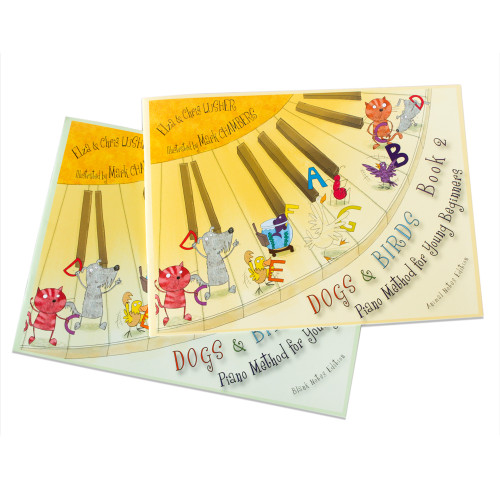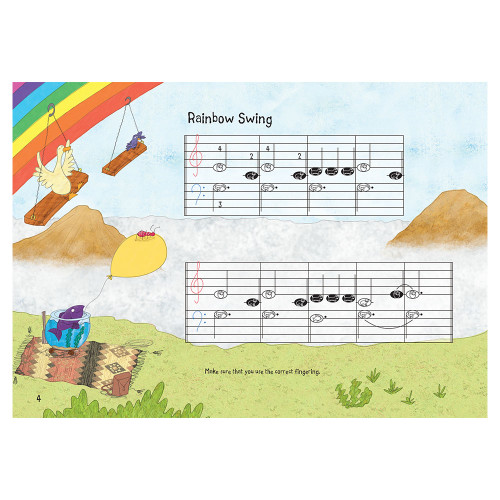Puppet Video Piano Lessons: 1 to 91 - SPECIAL SPRING OFFER: GET 50% DISCOUNT ON THIS BUNDLE
One year’s online access to all 3 parts of “Dorian and Miss Bell: Piano Lessons in the Forest”, sold a significant discount. Sixteen and a half hours of video for children of age 3 onwards, to be used in parallel with Dogs and Birds Book 1*.
The Advantages of Following These Lessons
- By watching each short video lesson your child will automatically pick up the singing, playing, tapping etc. by copying the puppets or the child demos.
- Dorian, the Dog puppet, and Miss Bell, the Bird puppet, shows you the approach to learning each musical element and, in a short insert, children demonstrate to you the final result of each lesson.
- These video lessons help parents and teachers to organize a learning path for the child as they work together on this musical adventure. No previous knowledge of music is required from the parent/helper.
- Games and toys are most important in a child’s life, and by using the finger puppets or their own toys, children will be more relaxed, imaginative and more connected during their practice time.
- Children will experience the pleasure of making music and day by day you will be delighted to see the increase in their concentration span and coordination skills.
* For best results it is suggested to use this course with the Dogs and Birds Book 1 Bundle, the Tiles and Staves Bundle, and the Dorian and Miss Bell Finger Puppets (all sold separately). These additional products can be purchased together with the full set of 91 videos in the Puppet Video Bundle, for a discounted price including free tracked shipping.
Watch 8 FREE sample videos here (worth £8)
Covered in video lessons 1 to 91
Things you will know after completing videos 1 to 30:
- Where the high and low notes are on the piano.
- How to play using what we call the “Owl’s Eyes” finger position. This allows even three- or four-year-old children, who have relatively weak fingers, to start playing a full sized piano, using a technique that is an excellent foundation for developing a good hand position with curved fingers as they grow older.
- You will be able to use both your blue (left) hand and your red (right) hand from the start, when playing pieces and tapping rhythm exercises.
- The difference between long notes (crotchets/quarter notes), medium notes (minims/half notes) and short notes (semibreves/whole notes).
- How to March, Count and Clap, to keep an even beat.
- The geography of the piano including the positions of EVERY Dog, Bird, Egg and Ant (D, B, E, and A).
- The positions of D, B and E closest to middle C on the musical staves.
- How to sing and play Dog, Bird, and Egg from the Blank Book (which doesn’t have the pictures of the Animals in the noteheads).
- You will be able to sing and play the first 15 musical pieces in Book 1 (up to page 14).
- All the 15 rhythm/tapping exercises in Book 1 up to page 12 including starting to tap different rhythms in both hands at the same time. This is excellent preparation for playing pieces hands together later on.
- How to listen and recognize Dog, Bird and Egg by ear.
- You will be able to sight-sing and sight-read Egg, Dog and Bird.
- How to paint different musical pictures on the piano, in order to develop important technique, and to express moods.
- You will be able to compose simple musical phrases/sentences, and write them out on the coloured staves.
Things you will know after completing videos 31 to 60:
- You will be able to play on the piano using a New finger position – the “Owl’s Glasses Fingers”, in addition to using “Owl’s Eyes Fingers”.
- How to focus on the correct arm, elbow and finger positions.
- How to understand Steps and Skips, and Up and Down, on both the piano keyboard and the musical staves.
- You will be able to appreciate the difference between 4 beats in a bar (Marching) and 3 beats in a bar (Dancing a Waltz).
- How to practise and deepen your knowledge of D, B and E, and learn the positions of the Ant and the Goose closest to middle C on the musical staves, and the positions of all the Geese on the piano keyboard.
- You will be able to sing and play the 21 new musical pieces in Book 1 from pages 14 to 30.
- How to sing and play from the Blank Book, including Ant and Goose.
- You will be able to play pieces where your red and blue hands play different sequences of notes at the same time – called playing “Hands Together”.
- You will be able to sight-sing and sight-read using Egg, Dog, Bird, Ant and Goose.
- Various musical games, including copy games, “pretending” games, “Spot the Mistakes”, “humming” games, and dancing.
- How to improve technique, dynamics, rhythm patterns, and singing, via improvisations and “playing stories”.
- You will be able to perform pieces that you have composed in the style of a March or a Lullaby.
- You will be able to listen and recognize Dog, Bird, Egg, Ant and Goose by ear, and link this with the use of body movement and reading the Large Coloured Staves.
- How to memorize rhythm patterns, and short musical phrases.
- You will be able to March, Count, Clap and Drum, simultaneously with your teacher/helper, but with different rhythm patterns.
- How to tap the 16 rhythm/tapping exercises from pages 16 to 28.
Things you will know after completing videos 61 to 91:
- You will be able to play using the new “Owl’s Goggles” and “Owl’s Binoculars” finger positions, and to mix them with “Owl’s Eyes” and “Owl’s Glasses” fingers,
- You will understand how to use dynamics in written notation, not just in “story playing”.
- How to tap the final 12 rhythm exercises in Book 1, and towards the end be able to tap with “Open Binoculars Fingers”.
- How ready you are to use “Open Fingering”, by going through the first piece in Book 2.
- The numbers of ALL your fingers on both your Red and Blue hands.
- The positions of all the Cats and Fish on the piano keyboard, and the position of the middle Cat on the musical staves. Also the positions of the first Goose above middle C, and the Fish just below and just above middle C on the musical staves.
- You will be able to sing and play the last 12 musical pieces in Book 1.
- You will be able to sing and play Cat and the low and high Fish from the Blank Book, as well as reinforcing your knowledge of G, A, B, D and E through practice.
- How to play “Twinkle, Twinkle, Little Star” from the Nursery Rhyme Book.
- You will be able to sing the blue hand part or the red hand part of a piece while playing the other part on the piano – this is much harder than playing the piece with both hands.
- How to March, Count, Clap and Drum more complicated rhythm patterns, including syncopation, and to read these without your helper.
- You will be able to read and tap very short notes (quavers/eighth notes).
- You will be able to count the beat aloud and evenly, while playing a piece.
- How to play a multi-player listening (ear training) game called ”Win the Tiles”.
- You will be able to hear the difference between perfect fifths and octaves, and to find and play them starting from any musical animal.
- How to play Happy (major) and Sad (minor) Chords on the piano, and to hear the difference between the two.
- You will be able to compose duets and count aloud together with your helper (partner) as you play, or add lyrics to them instead of counting the beat.
- You will understand what is meant by transposition, and will be able to use it to play the beginning of “Twinkle, Twinkle, Little Star” starting on each of the musical animals.
- You will be able to receive your well-deserved Certificate, to celebrate finishing the book.
- Videos:
- 91 Puppet Video Piano Lessons (16.5 hours of video content)
- Producer:
- Iain Lauchlan
- Puppets:
- Neil Sterenberg
- Animation:
- János Geng
- Composer:
- Elza and Chris Lusher
- Illustrator:
- Mark Chambers
- Copyright:
- Dogs and Birds
1 Review
-
Great teaching and practice assistant
Great beginner books, I have used them for a few years with my young beginner students, such a fun way to teach and learn, much easier to engage with the younger ones by using the puppets and stories. I have to say, the new puppet videos are a "life saver" for my students’ parents when it comes to practice. The children watch the short video first and practise (copy) accordingly. Generally the children like to watch how other kids are learning and they learn from them as a "peer group". More importantly, the puppet videos remind the parents and children how to practise correctly throughout the week. When I assign homework, I give out the number of the puppet video lesson to watch and by copying them my students make much faster progress. Thanks to Elza and Chris, what a blessing to the teachers and little ones who are using this method. Highly recommended!



























